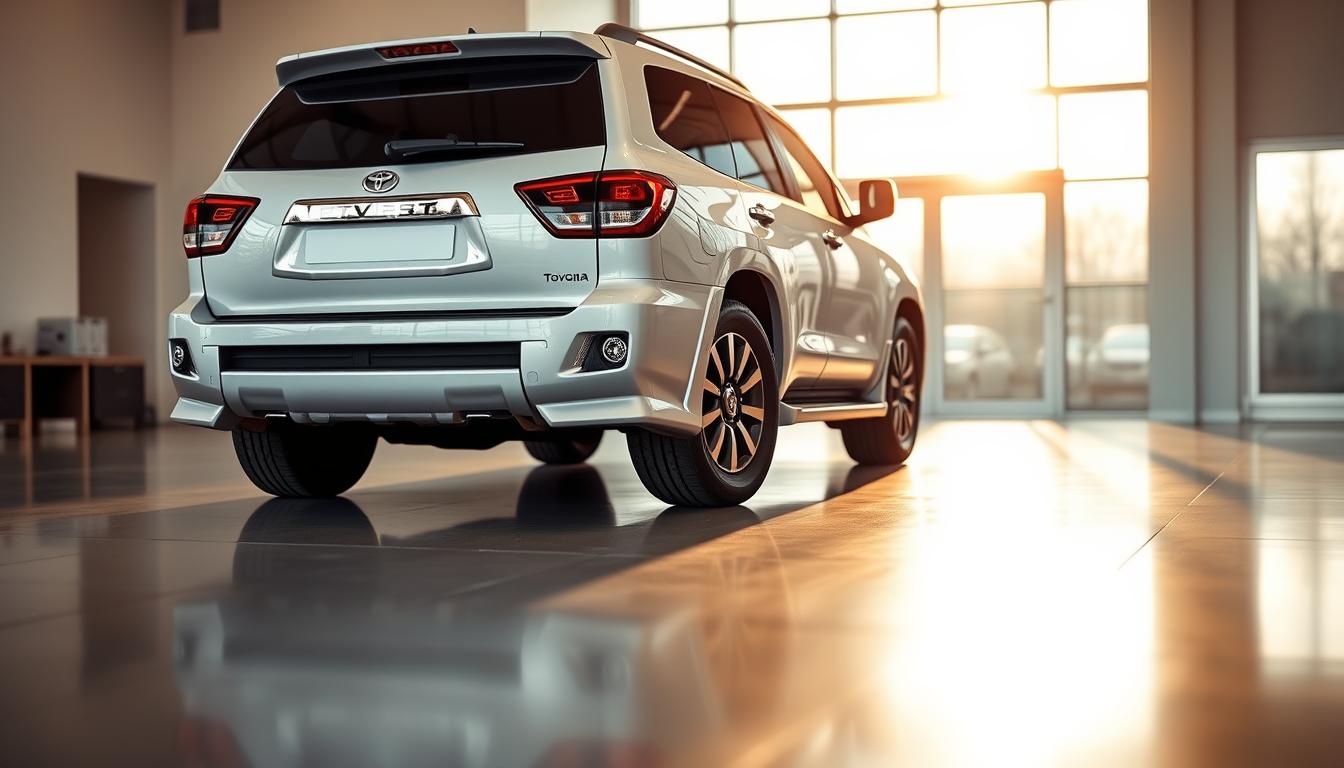Owning a full-size SUV doesn’t mean you have to lose money in the long run. The Sequoia is known for its remarkable staying power in the used car market. At Miller Toyota, sales managers say these models sell quickly, sometimes in just days.
What makes some owners get more money than others? It’s all about how well you take care of your SUV. Keeping it in top shape makes it more appealing to buyers. Regular maintenance is not just for reliability; it’s also a smart financial move.
Timing is also key. SUV demand goes up before family trips, making it a great time to sell. We’ll show you how to use maintenance, documentation, and market trends to get the best price for your SUV.
This guide is your roadmap to getting the most out of your Sequoia. We’ll share steps to turn good resale outcomes into great ones.
Understanding Toyota Sequoia Resale Value Factors
Knowing your SUV’s resale value is key. For Toyota Sequoia owners, certain factors affect its value over time. Let’s look at what keeps your SUV’s value high and how to avoid common issues.
Why Your SUV’s Future Value Should Matter Now
Full-size SUVs lose 49% of their value in five years, on average. But Toyota Sequoias can hold their value better with good care. A strong resale value means:
- Lower long-term costs
- Better trade-in value
- Faster private sales
Three Key Elements Shaping Sequoia Depreciation
While all vehicles lose value, these factors affect Sequoias the most:
1. Mileage Thresholds That Trigger Value Drops
Mount Airy Toyota’s data shows big value changes at certain miles:
| Mileage | Value Impact | Common Issues |
|---|---|---|
| 0-30k | Premium pricing | New car competition |
| 60k | 5-8% drop | First major service due |
| 100k | 12-15% drop | Suspension concerns |
2. Model Year Advantages You Can’t Ignore
2021-2023 models are special due to pandemic delays. These years:
- Have fewer recalls (check NHTSA database)
- Have Toyota’s latest safety tech
- Are in high demand
3. Trim Level Differences That Surprise Owners
While SR5s are popular, TRD Pros hold their value best. Here’s what sets them apart:
| Feature | TRD Pro | SR5 |
|---|---|---|
| 5-Year Resale | 56% | 48% |
| Unique Features | Fox shocks, skid plates | Standard tow package |
| Market Demand | +22% faster sales | Wider buyer pool |
Clean maintenance records can help keep your Sequoia’s value up. We’ll talk about keeping records in later sections to boost your SUV’s worth.
Proven Maintenance Strategies
Smart owners know that keeping a Toyota Sequoia’s value up starts before selling. It’s all about consistent, strategic care. Let’s look at maintenance tips that help protect your investment.
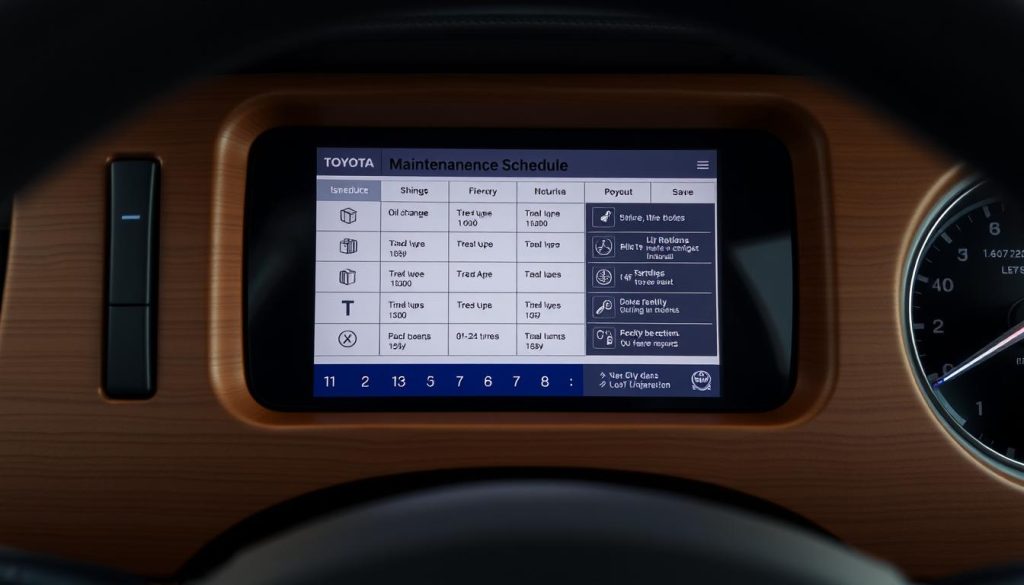
Routine Service Schedule Adherence
Miller Toyota service advisors say: “Vehicles don’t lose value – owners lose opportunities to preserve it.” Follow these tips:
Toyota’s Recommended Maintenance Timeline
- 5,000-mile oil changes are safer than longer intervals, dealerships advise
- Do multi-point inspections at every service (brakes, suspension, exhaust)
- Software updates during recall repairs improve vehicle history reports
Critical Service Intervals for Optimal Performance
| Mileage | Key Services | Resale Impact |
|---|---|---|
| 30,000 | Transmission fluid check | Preserves drivetrain warranty |
| 60,000 | Coolant replacement | Prevents corrosion claims |
| 90,000 | Spark plug replacement | Maintains fuel efficiency specs |
Fluid Change Best Practices
Mount Airy Toyota technicians say: “Neglected fluids account for 37% of value deductions during appraisals.” Focus on:
- Use synthetic oil for changes that match factory specs
- Flush transmissions with OEM-approved gear
- Replace brake fluid every 3 years, mileage aside
Tire Maintenance for Maximum Return
Rotate tires every 7,500 miles to:
- Keep tread wear patterns even for buyer checks
- Stop early differential wear in 4WD systems
- Show off thorough care in service records
“A vehicle with matching tire brands and even wear signals ‘responsible owner’ to buyers.”
Service Records: Your Secret Weapon
Your Toyota Sequoia’s service history is more than just repairs. It’s a financial asset when trading it in. Keeping detailed records shows you’ve taken good care of your SUV. This can help you get a better price when selling.
What Smart Buyers Look For in Paperwork
Smart shoppers look at three things: consistency, completeness, and credibility. Dealership records carry extra weight because they follow Toyota’s approved processes. But, as Copeland Toyota says, “Independent shop receipts also count if they show OEM parts and certified labor.”
Dealership vs Independent Shop Records
Dealership service histories usually have:
- Toyota Care maintenance schedules
- Manufacturer-recommended fluid specs
- Updates to Carfax reports
Independent mechanics can also meet these standards by:
- Noting Toyota part numbers on invoices
- Documenting torque specs for major repairs
- Providing before/after service photos
Mastering Receipt Organization
Miller Toyota suggests organizing recall paperwork this way:
- Keep warranty and out-of-pocket work in separate folders
- Highlight recall completion certificates in red
- Scan documents right away with your phone’s Notes app
Modern Solutions for Record Keeping
Digital tools help with storage and verification. Here are some options:
| Tool | Best For | CPO Ready? |
|---|---|---|
| Toyota Owners App | Real-time updates | Yes |
| Carfax Care | Third-party verification | Partial |
| Google Drive | DIY organization | No |
The Toyota Certified Pre-Owned program needs dealership records for 75% of services. A hybrid system works best. Store digital copies online but keep physical folders for big repairs. This way, your Toyota Sequoia’s trade-in value stays high, whether you sell it privately or through dealerships.
Interior Preservation Techniques
Your Toyota Sequoia’s cabin is like a staged home. Every detail matters to buyers. Keeping it in top shape can increase its value.
Upholstery Protection Methods
Seats and carpets face a lot of wear and tear. A Mount Airy dealership manager says: “Vehicles with pristine interiors sell 23% faster than average in our market.” Here are some tips to keep them looking new:
1. Seat Cover Recommendations
WeatherTech makes custom-fit covers that last longer than the originals. For leather, use a pH-balanced conditioner every month. Don’t use cheap covers that don’t fit right.
2. Carpet Preservation Strategies
- Install all-weather mats all year
- Vacuum weekly with a crevice tool
- Clean spills right away with baking soda
Controlling Odors and Stains
Detailing can get rid of tough smells for $150-$300. But, regular care is cheaper and just as effective. Here are some tips:
“Rotate cabin air filters every 12k miles – musty filters ruin clean interior air.”
| Solution | Cost | Effectiveness |
|---|---|---|
| Ozone treatment | $120+ | Eliminates smoke smells |
| Enzyme cleaners | $15-$40 | Removes organic stains |
Child Seat Installation Considerations
Wrong seat installations can damage 73% of seats, J.D. Power says. Here’s how to avoid that:
- Use waterproof pads under car seats
- Check anchor points monthly for fabric stress
- Remove seats when not in use
Exterior Protection Essentials
Your Toyota Sequoia’s outer look is its first impression when selling. Taking care of the exterior prevents damage and keeps it looking new. This is key to getting good resale prices.
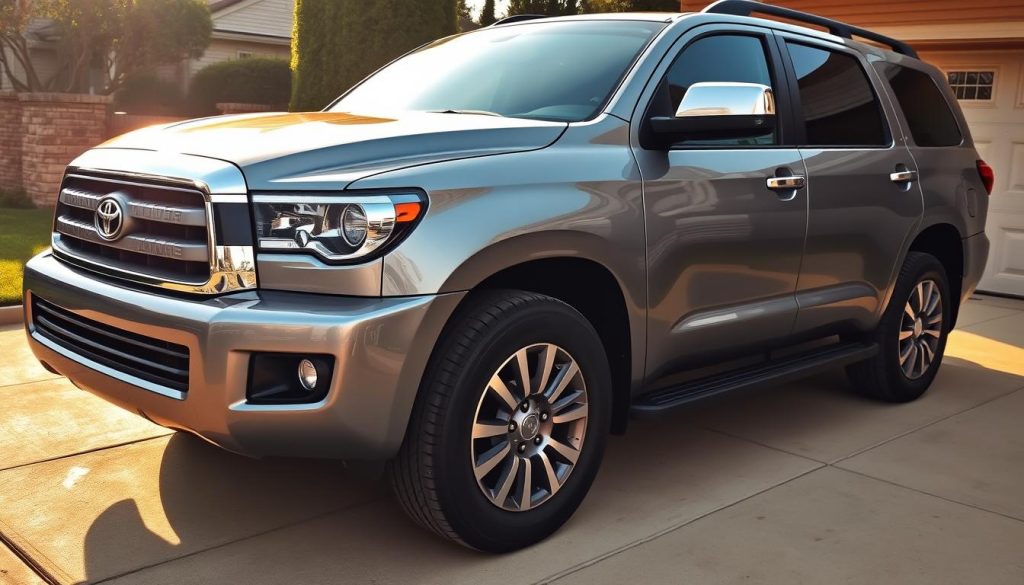
Paint Preservation Methods
A perfect paint job can boost offers by 8-12%, Miller Toyota found. There are two effective methods:
1. Waxing Frequency Guide
Use top-notch carnauba wax every 3 months or synthetic sealants every 6 months. In winter, you might need to wax more often because of salt and grime. Pro tip: Dry your car by hand to avoid water spots.
2. Ceramic Coating Cost-Benefit Analysis
Ceramic coatings cost $1,200-$2,500 but last 5+ years. Cars with this coating sell 15% faster. They also save on detailing costs over time.
Undercarriage Protection in Various Climates
Different areas face different threats:
- Northeastern states: Rubberized undercoating ($150-$300) fights rust from salt
- Southwestern regions: UV-resistant sprays ($80-$120) shield plastic from sun
Miller Toyota’s mechanics suggest checking suspension parts when switching tires to catch corrosion early.
Windshield and Glass Maintenance
A small chip can drop your car’s value by $500. Fix small damage right away:
- Small chips: $50-$150 to fix vs $400+ for a new windshield
- Deep cracks: Always replace the whole windshield ($600-$900)
Use glass cleaners weekly to keep your windshield clear and prevent stains from hard water.
Mechanical Longevity Tips
To keep your Toyota Sequoia running well, you need more than just occasional check-ups. You need smart maintenance strategies to fight the Toyota Sequoia depreciation rate. Let’s look at three key areas where taking care early can help a lot at resale time.
Engine Preservation Best Practices
Your Sequoia’s engine, whether V8 or hybrid, needs special care. Here’s how to keep it in great shape:
1. Oil Change Frequency Optimization
Modern synthetic oils let you go longer between oil changes. But don’t go too long. Follow this guide:
| Engine Type | Normal Use | Heavy Towing |
|---|---|---|
| 5.7L V8 | 7,500 miles | 5,000 miles |
| Hybrid | 10,000 miles | 7,500 miles |
2. Cooling System Maintenance
Stop overheating problems with these steps:
- Flush coolant every 60,000 miles
- Inspect hoses during oil changes
- Replace thermostat at 100,000 miles
“Fix small cooling leaks right away – a $20 hose replacement is better than a $2,000 engine fix.”
Transmission Care for High Mileage
The debate on transmission flushes goes on. Here’s what Sequoia owners need to know:
| Service Type | Recommended Interval | Risk Factor |
|---|---|---|
| Fluid Drain/Refill | 60,000 miles | Low |
| Full Flush | 100,000 miles | Medium* |
*Some mechanics say avoid flushes on transmissions over 150k miles
Suspension Component Inspections
Don’t wait for noises. Check these parts every 15,000 miles:
- Ball joints and tie rods
- Shock absorber seals
- Bushings in control arms
Remember – documented repairs to your suspension can slow down your Toyota Sequoia depreciation rate. It shows the car is well-maintained to future buyers.
Modifications That Hurt Value
Personalizing your Toyota Sequoia can be fun, but some changes might hurt your wallet when you trade it in. We’ll look at upgrades that often don’t pay off when you sell.
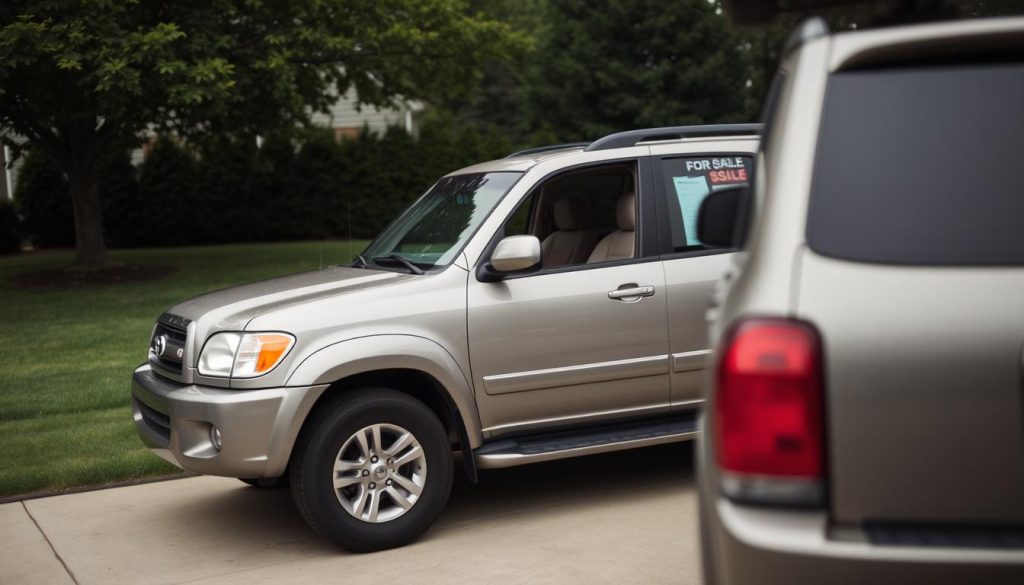
Aftermarket Upgrades to Avoid
Changes that alter the factory specs can be a problem for buyers. Dealerships like Copeland Toyota use OEM parts for a reason. Aftermarket changes can lead to maintenance issues later on.
1. Lift Kit Drawbacks
Lifted trucks might look cool, but they have downsides. These include:
- Voiding suspension warranties
- Wearing out drivetrain parts faster
- Lowering fuel efficiency by 15-20%
A 3″ lift kit might seem tough, but our comparison shows modified Sequoias sell for 12-18% less than stock ones in similar shape.
2. Exhaust System Modifications
Louder exhausts aren’t always a plus in the SUV market. They can lead to:
- Emissions problems
- Higher insurance costs (as mentioned in Section 16)
- Scaring off family-focused buyers
Wheel/Tire Combinations That Decrease Appeal
Oversized tires and flashy rims cause three main issues:
- Speedometer errors
- Lower towing capacity
- Sooner wear on steering parts
| Modification Type | Resale Impact | Buyer Concerns |
|---|---|---|
| Oversized Tires (+3″) | -9% Value | Ride comfort, maintenance costs |
| Chrome Aftermarket Wheels | -6% Value | Corrosion risks, mismatch with OEM specs |
| Low-Profile Tires | -7% Value | Less off-road capability |
Choose Toyota-approved accessories if you’re thinking of making changes. A Ford F-150 owner learned the hard way: “My $4,000 wheel upgrade only added $800 to my trade-in offer.”
Current Resale Market Trends
The SUV market is changing fast, with Toyota Sequoia values showing how the economy and what people want are shifting. Knowing these trends helps owners decide the best time and place to sell.
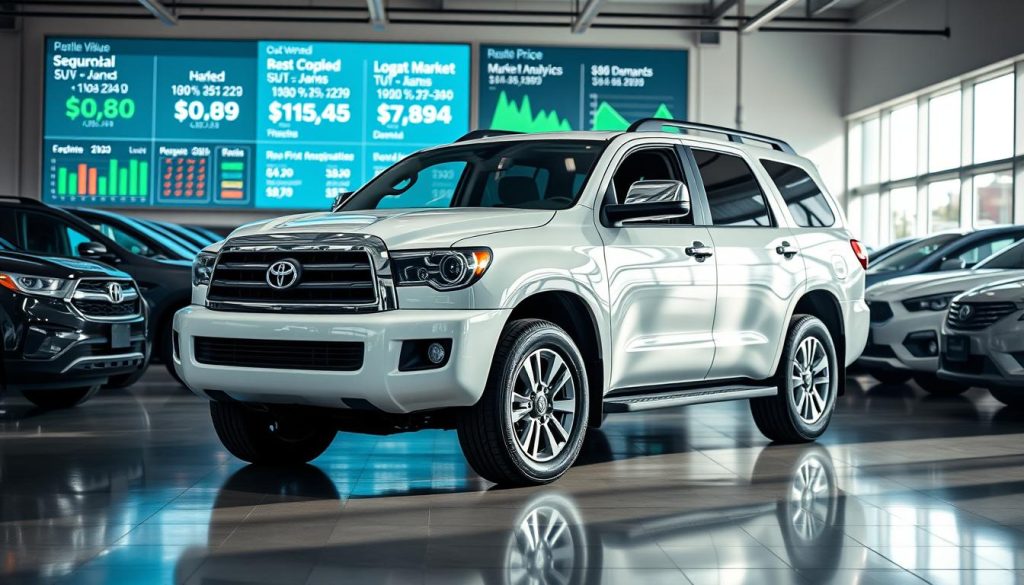
2023-2024 Market Analysis
Sequoia values are leveling out after the pandemic. Prices hit highs in 2022 due to a lack of cars, but 2023 saw a more even market. Experts think this balance will keep going into 2024 as car supplies get back to normal.
1. Pandemic Market Adjustments
The COVID-19 pandemic caused unusual drops in value. Many 2020-2022 models kept 85-90% of their value after three years, which is about 15% more than before the pandemic. But, as more cars become available, this trend is starting to fade.
2. Hybrid Model Impact Predictions
Toyota’s new hybrid Sequoia trim might change the market. Here’s what early signs suggest:
- Gas V8 models might lose value 3-5% faster
- Hybrid versions could keep 7% more value after 5 years
- Fuel efficiency is becoming a big deal for buyers
Regional Value Variations in the US
The area where you sell your Sequoia affects its value. Here are some regional differences to keep in mind:
| Region | Avg. Price Premium | Key Factors |
|---|---|---|
| Sun Belt States | +12% | Lower rust risk, higher demand for tow vehicles |
| Rust Belt States | -8% | Salt damage concerns, shorter ownership cycles |
| Mountain West | +5% | 4WD preference, limited inventory |
| Northeast Metro | +3% | Family vehicle demand, certified pre-owned interest |
Coastal areas like the Sun Belt prefer Sequoias in good shape with third-row seating and tow packages. In contrast, the Midwest values lower-mileage cars with winter packages.
Optimal Selling Timeline
When you sell your Toyota Sequoia, timing is everything. Owners who sell at the right time can get the best value. They use mileage, seasonal trends, and model years to their advantage. Let’s look at the three main factors that affect your profit.
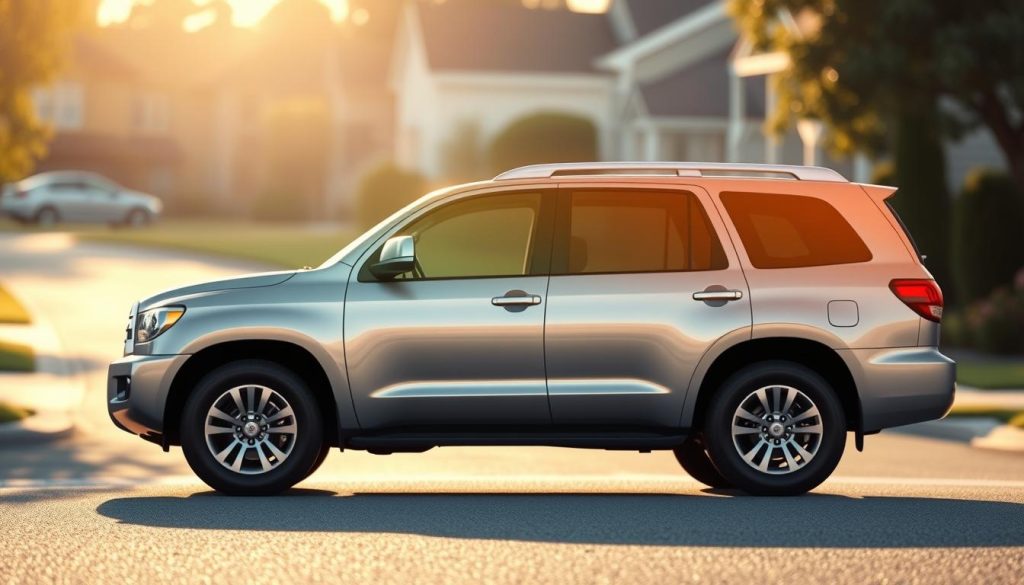
Mileage Sweet Spots for Selling
The odometer reading is key for buyers. Sequoias are known for lasting long, but certain mileage levels are more appealing:
- Under 70k miles: Gets top dollar for being “low mileage”
- 70k-90k miles: A good balance of age and value
- Pre-100k mark: A psychological barrier in negotiations
Dealers in Mount Airy say winter is a good time to sell SUVs, even with higher mileage. But, hitting six figures can lower the price by 12-18%.
Seasonal Selling Advantages
SUV sales have a yearly pattern. Here are some timing tips:
| Season | Advantage | Best For |
|---|---|---|
| Tax Season (Feb-April) | Buyers with refunds | Higher trim models |
| Winter Demand (Nov-Jan) | 4WD premium | Northern states |
| Model Year Transition (Aug-Oct) | New inventory gaps | Recent model years |
Model Year Transition Timing
New Sequoia models come out in late summer. This is the best time to sell the old ones. Dealers pay more for older models to keep their certified pre-owned stock balanced.
Pro Tip: List your Sequoia 2-3 weeks before the new model comes out. This attracts both early upgraders and those who don’t want to pay more for the latest models.
Pricing Strategy Development
Creating a winning price plan for your Toyota Sequoia is all about research and psychology. It’s about using data and understanding buyer behavior to find the perfect balance. This balance maximizes profit and attracts serious buyers. Let’s explore the tools and tactics that lead to premium returns.
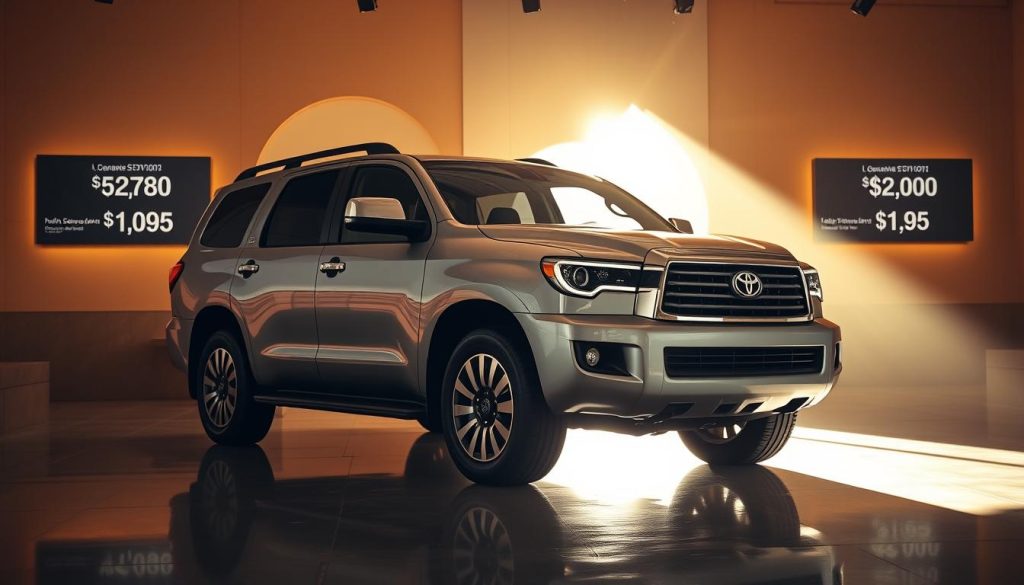
Decoding the Market’s Language
Start your pricing journey with these three powerhouse tools:
1. Online Valuation Showdown
Not all estimators speak the same language. This comparison reveals key differences:
| Tool | Best For | Data Source | Notes |
|---|---|---|---|
| KBB Instant Cash Offer | Quick dealer quotes | National dealer network | Includes local demand factors |
| Edmunds Appraisal Tool | Private sale ranges | Recent sales data | Shows price trends over time |
| Copeland/Mount Airy System | Regional comparisons | Multi-state auctions | Highlights geographic value gaps |
2. Neighborhood Detective Work
Your local market tells the real story. Try these hyper-local strategies:
- Visit three dealerships within 25 miles – note their Sequoia inventory ages
- Track Facebook Marketplace listings for 2 weeks – record how fast trucks sell
- Chat with service managers – ask what features buyers request most
Mastering the Money Talk
Arm yourself with these negotiation essentials:
- Print competing offers from different sources (keep dealer quotes separate from private valuations)
- Determine your absolute lowest acceptable price – then add 4% as your starting point
- Practice responding to common objections: “I understand your concern – let’s compare these recent sales…”
Remember, buyers respect sellers who can justify their pricing logically. Pair your Toyota Sequoia’s maintenance records with current market snapshots to build a strong value argument.
Professional Detailing Benefits
Getting your Toyota Sequoia detailed can be the best $100 investment before selling. Miller Toyota’s team says “a showroom-ready SUV often commands $500+ more than comparable models”. This shows how a little cleaning can make a big difference in your car’s value.
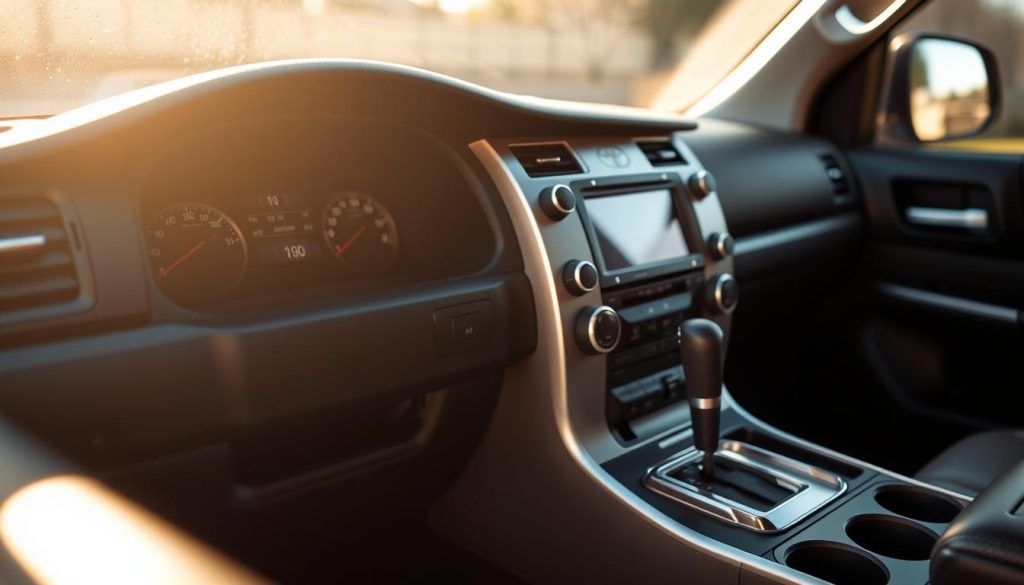
Pre-Sale Detailing Checklist
Here’s a 5-step plan to attract more buyers:
- Deep-clean interiors: Steam clean carpets and treat leather seats
- Paint correction: Use clay bar treatment to remove contaminants
- Engine bay wipe-down: Remove visible grease without water exposure
- Odor elimination: Professional ozone treatment for smoke/pet smells
- Final touch-up: Restore black trim and apply tire shine
Cost vs Return on Professional Services
Here’s why hiring pros is often better than DIY:
| Service | Average Cost | Value Increase |
|---|---|---|
| Exterior Wash & Wax | $75 | $200 |
| Interior Deep Clean | $150 | $350 |
| Full Clay Bar Treatment | $250 | $600 |
DIY Detailing Tips for Budget-Conscious Owners
For those doing it themselves:
- Use pH-neutral cleaners to preserve surfaces
- Invest in quality microfiber towels ($20 kit prevents swirl marks)
- Apply spray wax after every wash for lasting protection
Don’t use dish soap – it damages protective coatings. Focus on areas like cup holders and door jambs where buyers check closely.
Certified Pre-Owned Advantages
Choosing a certified pre-owned (CPO) Toyota Sequoia offers unique benefits. These vehicles often sell for more and come with a warranty. They also pass strict quality checks.
What It Takes to Earn CPO Status
Toyota sets high standards for CPO vehicles. Each Sequoia must pass a 160-point inspection. This includes:
- Engine performance diagnostics
- Transmission fluid analysis
- Brake system evaluation
- Frame integrity verification
Only vehicles under 6 years old with fewer than 85,000 miles qualify. Dealers must replace worn parts and provide a complete service history before certification.
CPO vs Private Sale Value Comparison
| Feature | CPO Sequoia | Private Sale |
|---|---|---|
| Average Price Premium | 12-18% Higher | Market Rate |
| Warranty Coverage | 7-Year/100k Mile | None |
| Roadside Assistance | 2 Years Included | Optional |
“CPO SUVs sell 22% faster than non-certified models in competitive markets.”
Smart Certification Timing
Think about CPO status if your Sequoia:
- Has under 60,000 miles
- Is less than 4 years old
- Needs minor reconditioning
The $500-$800 certification cost often pays for itself. This is true for best resale value Toyota Sequoia models in areas with high SUV demand.
Trade-In vs Private Sale
Deciding whether to trade in or sell your Toyota Sequoia privately can be tricky. Both paths have their benefits, depending on what matters most to you. We’ll explore how to choose the best option for your financial goals.
Pros and Cons at a Glance
Trading in your SUV at a dealership is quick, usually taking just 30 minutes. But, dealers often pay 10-15% less than what you could get privately. Selling it yourself might bring in more money, but it takes more time and effort.
| Factor | Trade-In | Private Sale |
|---|---|---|
| Time Investment | 1-2 hours | 2-4 weeks |
| Average Profit | $28,500 | $32,900 |
| Tax Benefit | Reduces new car sales tax | None |
“Always get three dealer appraisals minimum – competing offers give you negotiation power,”
Maximizing Dealer Trade Value
To get the most for your Toyota Sequoia trade-in:
- Request appraisals from three dealerships minimum
- Time your trade during new model releases
- Highlight recent maintenance using digital service records
Many states offer sales tax credits. For example, a $40,000 trade value could save you $2,800 in taxes on a new car. Dealers might pay more if they need specific models – check local SUV demand first.
Executing a Safe Private Sale
For private sales:
- Use secure meetup locations like police station parking lots
- Require cashier’s checks or escrow services
- Remove license plates upon payment
Set your asking price 7% above what you want to get. Good photos can increase interest by 40%, AutoTrader found. Always check your buyer’s ID and insurance before letting them test drive.
Competitor Comparison Analysis
Smart SUV shoppers always compare top models before making decisions. Let’s see how the Toyota Sequoia holds up against popular rivals in resale value. We’ll break down key differences using real-world data and market trends.
Sequoia vs Chevrolet Tahoe Resale Rates
The Chevrolet Tahoe maintains solid demand, but the Sequoia pulls ahead in long-term value. Over five years:
- Toyota Sequoia: 38% depreciation
- Chevrolet Tahoe: 45% depreciation
This gap widens in regions with harsh winters. The Sequoia’s standard all-wheel drive and rust-resistant undercarriage help it age better than rear-wheel-drive Tahoe models. Toyota’s legendary reliability also plays a role – repair costs average 22% lower than GM’s full-size SUV.
“Toyota’s truck-based SUVs consistently outperform domestic rivals in residual value calculations.”
Sequoia vs Ford Expedition Value Retention
Ford’s aluminum-body Expedition shines in fuel efficiency but stumbles in resale value. Key differences:
| Feature | Sequoia | Expedition |
|---|---|---|
| 5-Year Value Retention | 62% | 55% |
| Towing Capacity | 7,400 lbs | 6,600 lbs |
The Sequoia’s higher tow rating makes it more appealing to boat and trailer owners. Expedition owners often face higher insurance premiums due to complex repair requirements for aluminum body panels.
Sequoia vs Nissan Armada Depreciation
While both Japanese brands enjoy strong reputations, the Armada depreciates 12% faster than the Sequoia. Why the difference?
- Sequoia offers more standard safety features
- Toyota’s certified pre-owned program boosts secondary market confidence
- Armada’s V8 engine requires more frequent maintenance
Mountain states show the largest disparity – Sequoias hold 18% more value in Colorado’s rugged terrain. The Armada’s unibody construction struggles to maintain appeal among off-road enthusiasts compared to Toyota’s body-on-frame design.
Insurance Impact on Resale
Your Toyota Sequoia’s insurance choices matter a lot for its resale value. Owners often focus on keeping the car in good shape and low mileage. But, buyers also look at insurance details to find hidden risks.
There are three key areas where your insurance choices affect your SUV’s appeal. Let’s dive into these areas.
How Claims History Affects Value
Every insurance claim leaves a mark. Carfax reports show accidents with damage over $1,000 as a red flag. Such incidents can lower your Sequoia’s resale price by 15-25%.
For small dents or windshield chips, think twice before claiming. A single claim for minor repairs can hurt your car’s value in the long run. Always ask for repair documents, even for small fixes.
Gap Insurance Considerations
Gap insurance helps if you owe more on your loan than your car is worth. It doesn’t directly increase resale value. But, it helps avoid negative equity, which can scare off buyers.
Pro Tip: Cancel gap insurance when your loan balance is less than your car’s value. Most people don’t need it after 3-4 years.
Maintaining Clean Title Status
A branded title can cut your Sequoia’s value by 40% or more. To keep your title clean:
- Report recall repairs through Toyota’s official channels
- Avoid insurance write-offs for fixable damage
- Check title accuracy before transferring ownership
Even small accidents are less damaging if you have complete service records. Keep all recall completion certificates. They show your repairs met factory standards.
Conclusion
Keeping your Toyota Sequoia’s resale value high needs both planning and action. Owners who stick to the factory’s maintenance schedule and keep service records see better results. Miller Toyota’s sales data shows that well-kept 2020-2022 models sell faster than others.
When it’s time to sell, timing is everything. List your SUV before new models come out or during the spring and fall buying peaks. A $300 detailing job can add $1,500+ to your sale price, studies say.
Dealerships like Miller Toyota’s certified pre-owned program show how factory-backed certifications build trust. Highlight your Sequoia’s service history and original features when selling. Talk to local Toyota experts to check your vehicle’s market value and consider certification if it’s under 85,000 miles.
Owners who take care of their Sequoia and time their sale right can get great returns. With the right care and planning, your SUV can bring in top dollar, showing its worth as a family and adventure vehicle.
FAQ
How does the TRD Pro trim hold its value compared to SR5 models?
TRD Pro models keep 7-9% more value than SR5 trims. This is because they come with off-road-ready features like Fox shocks and skid plates. A 2022 TRD Pro with 30k miles usually sells for k, while a comparable SR5 sells for k.
Pandemic-era production delays made TRD Pro models scarcer. This scarcity boosted their resale value.
Why does dealership service history matter for resale?
Dealership records prove NHTSA recall verification and show Toyota Care schedule adherence. Miller Toyota says vehicles with dealer service histories sell
FAQ
How does the TRD Pro trim hold its value compared to SR5 models?
TRD Pro models keep 7-9% more value than SR5 trims. This is because they come with off-road-ready features like Fox shocks and skid plates. A 2022 TRD Pro with 30k miles usually sells for $58k, while a comparable SR5 sells for $53k.
Pandemic-era production delays made TRD Pro models scarcer. This scarcity boosted their resale value.
Why does dealership service history matter for resale?
Dealership records prove NHTSA recall verification and show Toyota Care schedule adherence. Miller Toyota says vehicles with dealer service histories sell $1,200-$1,800 higher than DIY-maintained ones. CPO certification needs dealership documentation, including proof of 5,000-mile oil changes.
Should I follow 5,000 or 10,000-mile oil change intervals?
Mount Airy Toyota suggests 5,000-mile intervals with 0W-20 synthetic oil, even for V8 models. Their data shows engines with frequent changes have 23% lower wear metal concentrations. Toyota allows 10k intervals, but shorter cycles prevent sludge issues that can reduce trade-in values by 15%.
How do WeatherTech accessories impact resale?
Professionally installed WeatherTech floor liners add $350-$500 in perceived value compared to worn OEM carpets. But, avoid non-OEM body modifications. A CARFAX study shows lifted Sequoias with aftermarket wheels sell 18% slower than stock configurations. Keep all OEM parts for reinstallation.
Does climate affect Sequoia depreciation rates?
Yes. Rust Belt models depreciate 2.5% faster annually than Sun Belt counterparts. Southwest UV damage causes $1,200-$1,800 in interior restoration costs that hurt trade-ins. Northeastern dealers recommend annual fluid film undercoating ($150-$250) to prevent frame corrosion.
How do hybrid models impact gas V8 values?
Early data shows 2023+ i-FORCE MAX hybrids depreciate 11% slower than V8 models due to fuel efficiency gains. Yet, V8s dominate the used market – Gasoline models account for 83% of 2022 Sequoia sales per Edmunds. Sell V8 models before 100k miles when hybrid demand peaks.
What’s better – Carfax reports or digital maintenance logs?
Use both. CARFAX validates accident history (repairs under $2,500 don’t trigger title brands), while apps like Toyota’s Service History provide time-stamped fluid change records. CPO verification requires dealership documentation, but private buyers increasingly demand digital proof – 67% of AutoTrader shoppers prioritize vehicles with digital logs.
Should I pay for professional detailing before selling?
Yes. A $100-$150 exterior detail with clay bar treatment typically yields $400-$600 in increased offers. Miller Toyota’s “real estate staging” approach – shampooing carpets, cleaning vents, and restoring trim – helps 82% of sellers exceed KBB Fair Condition values. Avoid DIY wax jobs that might swirl clearcoat.
How do transmission services affect resale?
Controversial but critical. While Toyota claims lifetime fluid, dealers like Copeland recommend 60k-mile drain-and-fills ($225-$300). Units with verifiable transmission service history sell 9 days faster on average. Modified Sequoias with aftermarket coolers actually see 12% value penalties from perceived abuse.
When is the best tax season timing for selling?
Target late March to mid-April when refund checks arrive. February trade-in values dip 3-5% as dealers clear inventory, while May sees 17% more CPO competition. Use KBB Instant Cash Offer alongside Edmunds Appraisal Tool – dealers often match or beat online quotes by $800-$1,200 to secure inventory.
,200-
FAQ
How does the TRD Pro trim hold its value compared to SR5 models?
TRD Pro models keep 7-9% more value than SR5 trims. This is because they come with off-road-ready features like Fox shocks and skid plates. A 2022 TRD Pro with 30k miles usually sells for $58k, while a comparable SR5 sells for $53k.
Pandemic-era production delays made TRD Pro models scarcer. This scarcity boosted their resale value.
Why does dealership service history matter for resale?
Dealership records prove NHTSA recall verification and show Toyota Care schedule adherence. Miller Toyota says vehicles with dealer service histories sell $1,200-$1,800 higher than DIY-maintained ones. CPO certification needs dealership documentation, including proof of 5,000-mile oil changes.
Should I follow 5,000 or 10,000-mile oil change intervals?
Mount Airy Toyota suggests 5,000-mile intervals with 0W-20 synthetic oil, even for V8 models. Their data shows engines with frequent changes have 23% lower wear metal concentrations. Toyota allows 10k intervals, but shorter cycles prevent sludge issues that can reduce trade-in values by 15%.
How do WeatherTech accessories impact resale?
Professionally installed WeatherTech floor liners add $350-$500 in perceived value compared to worn OEM carpets. But, avoid non-OEM body modifications. A CARFAX study shows lifted Sequoias with aftermarket wheels sell 18% slower than stock configurations. Keep all OEM parts for reinstallation.
Does climate affect Sequoia depreciation rates?
Yes. Rust Belt models depreciate 2.5% faster annually than Sun Belt counterparts. Southwest UV damage causes $1,200-$1,800 in interior restoration costs that hurt trade-ins. Northeastern dealers recommend annual fluid film undercoating ($150-$250) to prevent frame corrosion.
How do hybrid models impact gas V8 values?
Early data shows 2023+ i-FORCE MAX hybrids depreciate 11% slower than V8 models due to fuel efficiency gains. Yet, V8s dominate the used market – Gasoline models account for 83% of 2022 Sequoia sales per Edmunds. Sell V8 models before 100k miles when hybrid demand peaks.
What’s better – Carfax reports or digital maintenance logs?
Use both. CARFAX validates accident history (repairs under $2,500 don’t trigger title brands), while apps like Toyota’s Service History provide time-stamped fluid change records. CPO verification requires dealership documentation, but private buyers increasingly demand digital proof – 67% of AutoTrader shoppers prioritize vehicles with digital logs.
Should I pay for professional detailing before selling?
Yes. A $100-$150 exterior detail with clay bar treatment typically yields $400-$600 in increased offers. Miller Toyota’s “real estate staging” approach – shampooing carpets, cleaning vents, and restoring trim – helps 82% of sellers exceed KBB Fair Condition values. Avoid DIY wax jobs that might swirl clearcoat.
How do transmission services affect resale?
Controversial but critical. While Toyota claims lifetime fluid, dealers like Copeland recommend 60k-mile drain-and-fills ($225-$300). Units with verifiable transmission service history sell 9 days faster on average. Modified Sequoias with aftermarket coolers actually see 12% value penalties from perceived abuse.
When is the best tax season timing for selling?
Target late March to mid-April when refund checks arrive. February trade-in values dip 3-5% as dealers clear inventory, while May sees 17% more CPO competition. Use KBB Instant Cash Offer alongside Edmunds Appraisal Tool – dealers often match or beat online quotes by $800-$1,200 to secure inventory.
,800 higher than DIY-maintained ones. CPO certification needs dealership documentation, including proof of 5,000-mile oil changes.
Should I follow 5,000 or 10,000-mile oil change intervals?
Mount Airy Toyota suggests 5,000-mile intervals with 0W-20 synthetic oil, even for V8 models. Their data shows engines with frequent changes have 23% lower wear metal concentrations. Toyota allows 10k intervals, but shorter cycles prevent sludge issues that can reduce trade-in values by 15%.
How do WeatherTech accessories impact resale?
Professionally installed WeatherTech floor liners add 0-0 in perceived value compared to worn OEM carpets. But, avoid non-OEM body modifications. A CARFAX study shows lifted Sequoias with aftermarket wheels sell 18% slower than stock configurations. Keep all OEM parts for reinstallation.
Does climate affect Sequoia depreciation rates?
Yes. Rust Belt models depreciate 2.5% faster annually than Sun Belt counterparts. Southwest UV damage causes
FAQ
How does the TRD Pro trim hold its value compared to SR5 models?
TRD Pro models keep 7-9% more value than SR5 trims. This is because they come with off-road-ready features like Fox shocks and skid plates. A 2022 TRD Pro with 30k miles usually sells for $58k, while a comparable SR5 sells for $53k.
Pandemic-era production delays made TRD Pro models scarcer. This scarcity boosted their resale value.
Why does dealership service history matter for resale?
Dealership records prove NHTSA recall verification and show Toyota Care schedule adherence. Miller Toyota says vehicles with dealer service histories sell $1,200-$1,800 higher than DIY-maintained ones. CPO certification needs dealership documentation, including proof of 5,000-mile oil changes.
Should I follow 5,000 or 10,000-mile oil change intervals?
Mount Airy Toyota suggests 5,000-mile intervals with 0W-20 synthetic oil, even for V8 models. Their data shows engines with frequent changes have 23% lower wear metal concentrations. Toyota allows 10k intervals, but shorter cycles prevent sludge issues that can reduce trade-in values by 15%.
How do WeatherTech accessories impact resale?
Professionally installed WeatherTech floor liners add $350-$500 in perceived value compared to worn OEM carpets. But, avoid non-OEM body modifications. A CARFAX study shows lifted Sequoias with aftermarket wheels sell 18% slower than stock configurations. Keep all OEM parts for reinstallation.
Does climate affect Sequoia depreciation rates?
Yes. Rust Belt models depreciate 2.5% faster annually than Sun Belt counterparts. Southwest UV damage causes $1,200-$1,800 in interior restoration costs that hurt trade-ins. Northeastern dealers recommend annual fluid film undercoating ($150-$250) to prevent frame corrosion.
How do hybrid models impact gas V8 values?
Early data shows 2023+ i-FORCE MAX hybrids depreciate 11% slower than V8 models due to fuel efficiency gains. Yet, V8s dominate the used market – Gasoline models account for 83% of 2022 Sequoia sales per Edmunds. Sell V8 models before 100k miles when hybrid demand peaks.
What’s better – Carfax reports or digital maintenance logs?
Use both. CARFAX validates accident history (repairs under $2,500 don’t trigger title brands), while apps like Toyota’s Service History provide time-stamped fluid change records. CPO verification requires dealership documentation, but private buyers increasingly demand digital proof – 67% of AutoTrader shoppers prioritize vehicles with digital logs.
Should I pay for professional detailing before selling?
Yes. A $100-$150 exterior detail with clay bar treatment typically yields $400-$600 in increased offers. Miller Toyota’s “real estate staging” approach – shampooing carpets, cleaning vents, and restoring trim – helps 82% of sellers exceed KBB Fair Condition values. Avoid DIY wax jobs that might swirl clearcoat.
How do transmission services affect resale?
Controversial but critical. While Toyota claims lifetime fluid, dealers like Copeland recommend 60k-mile drain-and-fills ($225-$300). Units with verifiable transmission service history sell 9 days faster on average. Modified Sequoias with aftermarket coolers actually see 12% value penalties from perceived abuse.
When is the best tax season timing for selling?
Target late March to mid-April when refund checks arrive. February trade-in values dip 3-5% as dealers clear inventory, while May sees 17% more CPO competition. Use KBB Instant Cash Offer alongside Edmunds Appraisal Tool – dealers often match or beat online quotes by $800-$1,200 to secure inventory.
,200-
FAQ
How does the TRD Pro trim hold its value compared to SR5 models?
TRD Pro models keep 7-9% more value than SR5 trims. This is because they come with off-road-ready features like Fox shocks and skid plates. A 2022 TRD Pro with 30k miles usually sells for $58k, while a comparable SR5 sells for $53k.
Pandemic-era production delays made TRD Pro models scarcer. This scarcity boosted their resale value.
Why does dealership service history matter for resale?
Dealership records prove NHTSA recall verification and show Toyota Care schedule adherence. Miller Toyota says vehicles with dealer service histories sell $1,200-$1,800 higher than DIY-maintained ones. CPO certification needs dealership documentation, including proof of 5,000-mile oil changes.
Should I follow 5,000 or 10,000-mile oil change intervals?
Mount Airy Toyota suggests 5,000-mile intervals with 0W-20 synthetic oil, even for V8 models. Their data shows engines with frequent changes have 23% lower wear metal concentrations. Toyota allows 10k intervals, but shorter cycles prevent sludge issues that can reduce trade-in values by 15%.
How do WeatherTech accessories impact resale?
Professionally installed WeatherTech floor liners add $350-$500 in perceived value compared to worn OEM carpets. But, avoid non-OEM body modifications. A CARFAX study shows lifted Sequoias with aftermarket wheels sell 18% slower than stock configurations. Keep all OEM parts for reinstallation.
Does climate affect Sequoia depreciation rates?
Yes. Rust Belt models depreciate 2.5% faster annually than Sun Belt counterparts. Southwest UV damage causes $1,200-$1,800 in interior restoration costs that hurt trade-ins. Northeastern dealers recommend annual fluid film undercoating ($150-$250) to prevent frame corrosion.
How do hybrid models impact gas V8 values?
Early data shows 2023+ i-FORCE MAX hybrids depreciate 11% slower than V8 models due to fuel efficiency gains. Yet, V8s dominate the used market – Gasoline models account for 83% of 2022 Sequoia sales per Edmunds. Sell V8 models before 100k miles when hybrid demand peaks.
What’s better – Carfax reports or digital maintenance logs?
Use both. CARFAX validates accident history (repairs under $2,500 don’t trigger title brands), while apps like Toyota’s Service History provide time-stamped fluid change records. CPO verification requires dealership documentation, but private buyers increasingly demand digital proof – 67% of AutoTrader shoppers prioritize vehicles with digital logs.
Should I pay for professional detailing before selling?
Yes. A $100-$150 exterior detail with clay bar treatment typically yields $400-$600 in increased offers. Miller Toyota’s “real estate staging” approach – shampooing carpets, cleaning vents, and restoring trim – helps 82% of sellers exceed KBB Fair Condition values. Avoid DIY wax jobs that might swirl clearcoat.
How do transmission services affect resale?
Controversial but critical. While Toyota claims lifetime fluid, dealers like Copeland recommend 60k-mile drain-and-fills ($225-$300). Units with verifiable transmission service history sell 9 days faster on average. Modified Sequoias with aftermarket coolers actually see 12% value penalties from perceived abuse.
When is the best tax season timing for selling?
Target late March to mid-April when refund checks arrive. February trade-in values dip 3-5% as dealers clear inventory, while May sees 17% more CPO competition. Use KBB Instant Cash Offer alongside Edmunds Appraisal Tool – dealers often match or beat online quotes by $800-$1,200 to secure inventory.
,800 in interior restoration costs that hurt trade-ins. Northeastern dealers recommend annual fluid film undercoating (0-0) to prevent frame corrosion.
How do hybrid models impact gas V8 values?
Early data shows 2023+ i-FORCE MAX hybrids depreciate 11% slower than V8 models due to fuel efficiency gains. Yet, V8s dominate the used market – Gasoline models account for 83% of 2022 Sequoia sales per Edmunds. Sell V8 models before 100k miles when hybrid demand peaks.
What’s better – Carfax reports or digital maintenance logs?
Use both. CARFAX validates accident history (repairs under ,500 don’t trigger title brands), while apps like Toyota’s Service History provide time-stamped fluid change records. CPO verification requires dealership documentation, but private buyers increasingly demand digital proof – 67% of AutoTrader shoppers prioritize vehicles with digital logs.
Should I pay for professional detailing before selling?
Yes. A 0-0 exterior detail with clay bar treatment typically yields 0-0 in increased offers. Miller Toyota’s “real estate staging” approach – shampooing carpets, cleaning vents, and restoring trim – helps 82% of sellers exceed KBB Fair Condition values. Avoid DIY wax jobs that might swirl clearcoat.
How do transmission services affect resale?
Controversial but critical. While Toyota claims lifetime fluid, dealers like Copeland recommend 60k-mile drain-and-fills (5-0). Units with verifiable transmission service history sell 9 days faster on average. Modified Sequoias with aftermarket coolers actually see 12% value penalties from perceived abuse.
When is the best tax season timing for selling?
Target late March to mid-April when refund checks arrive. February trade-in values dip 3-5% as dealers clear inventory, while May sees 17% more CPO competition. Use KBB Instant Cash Offer alongside Edmunds Appraisal Tool – dealers often match or beat online quotes by 0-
FAQ
How does the TRD Pro trim hold its value compared to SR5 models?
TRD Pro models keep 7-9% more value than SR5 trims. This is because they come with off-road-ready features like Fox shocks and skid plates. A 2022 TRD Pro with 30k miles usually sells for $58k, while a comparable SR5 sells for $53k.
Pandemic-era production delays made TRD Pro models scarcer. This scarcity boosted their resale value.
Why does dealership service history matter for resale?
Dealership records prove NHTSA recall verification and show Toyota Care schedule adherence. Miller Toyota says vehicles with dealer service histories sell $1,200-$1,800 higher than DIY-maintained ones. CPO certification needs dealership documentation, including proof of 5,000-mile oil changes.
Should I follow 5,000 or 10,000-mile oil change intervals?
Mount Airy Toyota suggests 5,000-mile intervals with 0W-20 synthetic oil, even for V8 models. Their data shows engines with frequent changes have 23% lower wear metal concentrations. Toyota allows 10k intervals, but shorter cycles prevent sludge issues that can reduce trade-in values by 15%.
How do WeatherTech accessories impact resale?
Professionally installed WeatherTech floor liners add $350-$500 in perceived value compared to worn OEM carpets. But, avoid non-OEM body modifications. A CARFAX study shows lifted Sequoias with aftermarket wheels sell 18% slower than stock configurations. Keep all OEM parts for reinstallation.
Does climate affect Sequoia depreciation rates?
Yes. Rust Belt models depreciate 2.5% faster annually than Sun Belt counterparts. Southwest UV damage causes $1,200-$1,800 in interior restoration costs that hurt trade-ins. Northeastern dealers recommend annual fluid film undercoating ($150-$250) to prevent frame corrosion.
How do hybrid models impact gas V8 values?
Early data shows 2023+ i-FORCE MAX hybrids depreciate 11% slower than V8 models due to fuel efficiency gains. Yet, V8s dominate the used market – Gasoline models account for 83% of 2022 Sequoia sales per Edmunds. Sell V8 models before 100k miles when hybrid demand peaks.
What’s better – Carfax reports or digital maintenance logs?
Use both. CARFAX validates accident history (repairs under $2,500 don’t trigger title brands), while apps like Toyota’s Service History provide time-stamped fluid change records. CPO verification requires dealership documentation, but private buyers increasingly demand digital proof – 67% of AutoTrader shoppers prioritize vehicles with digital logs.
Should I pay for professional detailing before selling?
Yes. A $100-$150 exterior detail with clay bar treatment typically yields $400-$600 in increased offers. Miller Toyota’s “real estate staging” approach – shampooing carpets, cleaning vents, and restoring trim – helps 82% of sellers exceed KBB Fair Condition values. Avoid DIY wax jobs that might swirl clearcoat.
How do transmission services affect resale?
Controversial but critical. While Toyota claims lifetime fluid, dealers like Copeland recommend 60k-mile drain-and-fills ($225-$300). Units with verifiable transmission service history sell 9 days faster on average. Modified Sequoias with aftermarket coolers actually see 12% value penalties from perceived abuse.
When is the best tax season timing for selling?
Target late March to mid-April when refund checks arrive. February trade-in values dip 3-5% as dealers clear inventory, while May sees 17% more CPO competition. Use KBB Instant Cash Offer alongside Edmunds Appraisal Tool – dealers often match or beat online quotes by $800-$1,200 to secure inventory.
,200 to secure inventory.
